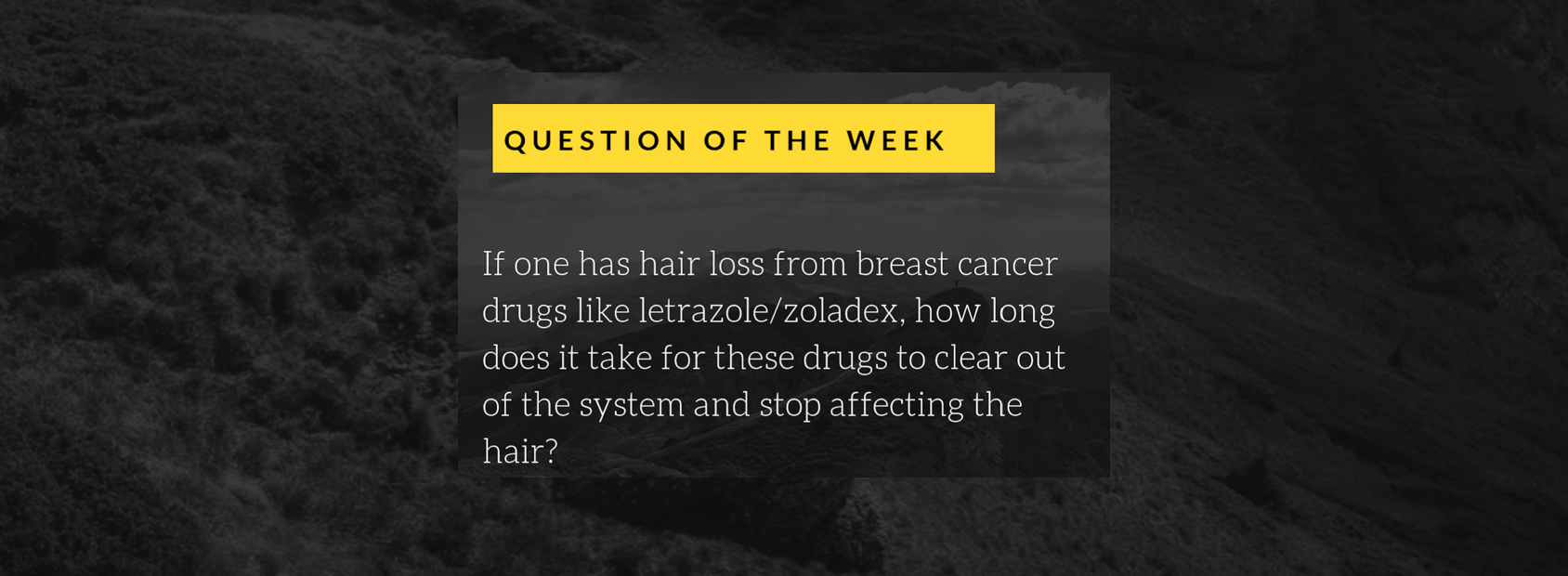QUESTION: Many of us on breast cancer drugs like Letrazole/Zoladex end up with hair loss. In my case, it occurred after a few months and was associated with an itchy scalp and diffuse shedding of 200+ hairs a day. Some have become very fine.
If one stops these drugs, how long does it generally take for them to clear out of the system and stop affecting the hair?
ANSWER
Thanks for the excellent and very important question. These types of questions and their answers are important for both patients and their doctors. These issues continue to be very much overlooked in the present day and so your question has broad relevance.
I’ll review the subject broadly and then return to your question.
Endocrine Therapy for Breast Cancer.
The breast cancer drugs you are referring to are broadly classified as ‘endocrine therapy.’ These drugs include three main categories: 1) the selective estrogen receptor modulators (SERMs), 2) aromatase inhibitors (AI) and 3) GnRH agonists. These drugs have shown benefits in the adjuvant and therapeutic setting for premenopausal or postmenopausal women with early-stage or advanced breast cancer. These drugs may be taken in some cases for 5-10 years to reduce the risk of recurrence.
SERMs. The selective estrogen receptor modulators include tamoxifen, raloxifene, and toremifene. These act as competitive inhibitors of estrogen binding to estrogen receptors. From this group, tamoxifen has been the most widely used for adjuvant endocrine therapy and is still the the gold standard for premenopausal patients at risk of recurrence.
AI. By contrast,aromatase inhibitors, including letrozole, anastrozole, and exemestane. These drugs inhibit the enzyme aromatase and thereby suppress plasma estrogen levels. These drugs are now considered the preferred option for adjuvant endocrine therapy in postmenopausal patients. They all appear to be comparable in efficacy and have similar AE profiles that include hot flashes, mood disorders, osteopenia, and arthralgias.
GnRH agonists. Gonadotropin releasing hormone agonists (GnRH) are used for premenopausal women with hormone receptor–positive breast cancer Drugs like leuprolide are prescribed to suppress estrogen production by the ovary and may be combined with other endocrine therapies or chemotherapies.
Breast cancer endocrine therapy induced alopecia (BC-EIA)
Hair loss is also a potential side effect of the medications used as ‘endocrine therapy’ discussed above including the SERMs, AI, and GnRH agonist. The type of hair loss that can occur in patients using these drugs is broadly referred to as “breast cancer endocrine therapy induced alopecia (BC-EIA)”
These changes come about because of the effects of hormone changes on the hair follicle - particularly the reduction in blood levels of estrogen (or estrogen related signals that are sent into cells) that accompanies use of these drugs. The hair follicle has a highly responsive endocrine organ. It produces hormones itself and responses quickly to changes in hormones in the body.
In 2013, the a meta-analysis of 13 415 patients in 35 clinical trials revealed an overall incidence of hair loss of 4.4%. The highest incidence in this study was with with the highest incidence in tamoxifen-treated patients (25%). In 2015, Moscetti and colleagues published data showing that about 8 % of 236 women using aromatase inhibitors stopped treatment on account of their hair loss.
HAIR LOSS IN PATIENTS USING ENDOCRINE THERAPY
The short answer to your question is that there can be more than one type of hair loss associated with these types of hormone blocking drugs. The main types of hair loss that are associated with these drugs include 1) acute telogen effluvium and 2) androgenetic alopecia.
Possibility 1: The Hair Loss is From a Drug Induced Telogen Effluvium
Telogen effluvium refer to a type of hair loss whereby the affected patient notices increased daily hair shedding. Instead of finding a few hairs in the shower or sink, the individual finds dozens and dozens or even hundreds. The key point here is that the shedding rate is increased over what is normal. Telogen effluvium from a drug typically occurs 2-3 months after the drug was started and can continue in some cases if the drug is continued. if a decision is made to stop the drug, the shedding can last 6-9 months after the drug is stopped.
Telogen effluvium is not common with tamoxifen. In fact, a 2014 study by Kanti et al did not show any changes in telogen hairs in 17 women using tamoxifen who were followed for 28 weeks. Although uncommon, tamoxifen related hair cycle changes are certainly possible and tamoxifen may have a growth inhibitory effects in some situations. Clearly a pure telogen effluvium is not like to be common but it can occur. A 2010 study by Bhatia et al showed that tamoxifen loaded liposomal topical formulation actually arrested hair growth in mice.
The aromatase inhibitors can also trigger a telogen effluvium. For example, Litt’s Drug Eruption Manual lists telogen effluvium from letrozole as occurring in less than 5 % of users.
Leuprolide, the GnRH agonist sometimes used in premenopausal women with breast cancer, may also cause a telogen effluvium. Litt’s Drug Eruption Manual lists telogen effluvium from Leuprolide as occurring in less than 5 % of users.
Possibility 2: The Hair Loss is From Patterned Alopecia (Androgenetic Alopecia)
The most important concept really understand is the development of androgenetic alopecia in women using endocrine therapy for breast cancer.
It’s becoming increasingly recognized that many of the hormone blocking drugs used to treat breast cancer can cause a type of hair loss that very much resembles male and female pattern balding (also called androgenetic alopecia and also called female pattern hair loss, FPHL). This type of hair loss is associated with an actual thinning of the hair strands and generally occurs in specific areas of the scalp. Women with FPHL notice that their hair is thinner and finer and this change typically affects the central scalp and crown area. The sides and the back can be affected as well but these areas are usually less affected than then middle and top of the scalp.
The drugs used as ‘endocrine therapy’ for breast cancer can cause a type of hair loss that very much resembles FPHL. It may be that women with breast cancer with underlying susceptibilities to FPHL (based on their family history or genetics) are more likely to develop this type of hair loss when they are prescribed endocrine therapy.
This type of hair loss is important to identify because it has a different course than the telogen effluvium discussed above. FPHL that develops from endocrine therapy does not improve over time if the drug is continued. Even with stopping of the drug, the hair density may not revert back to the original density. With stopping, however, the rate of hair loss may slow down or even stop.
Let me introduce you to a few important studies.
STUDY 1: Park et al 2014
In 2014, a group in Korea reported five cases of pattern alopecia in female patients who are undergoing anticancer hormonal based therapy (with aromatase inhibitors or selective estrogen receptor modulators) for the prevention of recurrence of breast cancer after surgery. This type of patterned alopecia developed after the full recovery of global hair loss of the entire scalp due to previous cytotoxic chemotherapy. The authors proposed that the androgen-estrogen imbalance caused by the drugs was thought to be the reason for the onset of pattern alopecia in the patients.
STUDY 2: Freites-Martinez A, et al 2018
in 2018, Freitas-Martinez and colleagues performed a retrospective cohort study of 112 patients with BC-ETIA. Alopecia was attributed to aromatase inhibitors in 75 patients (67%) and tamoxifen in 37 (33%). Severity was grade 1 in 96 of 104 patients (92%), and the pattern was similar to androgenetic alopecia.
STUDY 3: Gallicchio L et al. 2013
Gallicchio’s study showed that hair thinning was common with aromatase inhibitors and the chances of developing hair loss was not dependent on the age of the patient nor whether they had received chemotherapy in the past. The study was a survey-based study including a total of 851 female patients with breast cancer receiving aromatase inhibitors. 34% reported hair loss or hair thinning during their last month of therapy, and these hair changes were independent of previous chemotherapy and age.
Possibility 3: The Hair Loss is From A Different Reason Altogether
In patients who have hair loss after breast cancer treatment, one must consider a number of possibilities and keep an open mind. A number of possible reasons for hair loss after breast cancer include:
1) hair loss in the form of a telogen effluvium from the stress associated with illness
2) hair loss in the form of a telogen effluvium from one or more surgeries and the anesthetics involved in those surgeries
3) hair loss from chemotherapy, either a temporary or permanent form
4) hair loss from another issue such as a thyroid disorder, poor diet, cancer associated weight loss, or another medication used as part of treatment.
Treatment of Breast cancer endocrine therapy induced alopecia (BC-EIA)
The ideal treatment protocol for BC-ETIA remains to be determined. Hair loss with these endocrine therapies is known to have a significant effect on quality of life and this makes it imperative to develop strategies to address the hair loss.
Stopping the drug is not always an option as doing so may put the patient and highly increased risk of breast cancer recurrence. Such discussions about stopping require a thorough review by the oncologist and dermatologist.
Minoxidil may be one option for treating BC-ETIA. Freitas-Martinez and colleagues showed in 2018 that after treatment with topical minoxidil, moderate or significant improvement in alopecia was observed in 37 of 46 patients (80%). Low level laser may also be an options but this remains to be fully evaluated. Traditional anti-androgen options for addressing androgenetic alopecia in women such finasteride and spironolactone are usually not recommended for women who have been diagnosed with breat cancer.
Summary
Your question is and excellent one and I would encourage you to speak with your doctors about these issues I have raised here. Letrozole is an aromatase inhibitor and Zoladex is a GnRH type analogue. Both of these, as reviewed above, are part of what is termed endocrine therapy. While I can’t comment on whether what you have described truly fits the definition of breast cancer endocrine therapy induced alopecia (BC-EIA), certainly your description would suggest this.
Together with your physicians you can decide whether to continue these treatments or change treatments and whether to now begin specific hair loss treatments such as minoxidil. The data to date would suggest a reasonably good chance of improvement with minoxidil. In some patients minoxidil is combined with low level laser in attempt to further stimulate growth.
We don’t yet know if women with hair loss from one type of endocrine therapy are more or less susceptible to hair loss from another type of therapy. For example, we don’t yet know if women with hair loss from an aromatase inhibitor like Letrozole are less likely to have hair loss if they switch to tamoxifen. It would seem reasonable to conclude that the effects on the hair could be different.
Even with stopping a drug that may have caused BC-EIA hair may or may not improve. Some reduced shedding may occur if a culprit drug was stopped. But the pathways that were triggered often remain triggered to some degree which means the thinning does not revert back to normal in most people. With treatment of course, there can be an improvement.
Thank you again for the question.
Reference
Bhatia A, et al. Tamoxifen-loaded liposomal topical formulation arrests hair growth in mice. Br J Dermatol. 2010
Freites-Martinez A, et al. Endocrine Therapy-Induced Alopecia in Patients With Breast Cancer. JAMA Dermatol. 2018 Jun 1;154(6):670-675. doi: 10.1001/jamadermatol.2018.045
Gallicchio L et al. Aromatase inhibitor therapy and hair loss among breast cancer survivors. Breast Cancer Res Treat. 2013;142(2):435-443.
Kanti V, et al. Analysis of quantitative changes in hair growth during treatment with chemotherapy or tamoxifen in patients with breast cancer: a cohort study. Br J Dermatol. 2014.
Moscetti L, et al. Adjuvant aromatase inhibitor therapy in early breast cancer: what factors lead patients to discontinue treatment? Tumori. 2015;101(5):469-473.
Park J, et al. Pattern Alopecia during Hormonal Anticancer Therapy in Patients with Breast Cancer. Ann Dermatol. 2014.
Sagger V et al. Alopecia with endocrine therapies in patients with cancer. Oncologist. 2013;18(10):1126-1134.




